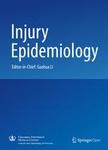版权所有:内蒙古大学图书馆 技术提供:维普资讯• 智图
内蒙古自治区呼和浩特市赛罕区大学西街235号 邮编: 010021

作者机构:Department of Biostatistics College of Public Health University of Kentucky Lexington KY United States Kentucky Injury Prevention and Research Center University of Kentucky Lexington KY United States Department of Health Management and Policy College of Public Health University of Kentucky Lexington KY United States Colorado Department of Public Health and Environment Denver CO United States Institute for Health and Equity Medical College of Wisconsin Milwaukee WI United States Department of Preventive Medicine and Environmental Health College of Public Health University of Kentucky Lexington United States
出 版 物:《Injury Epidemiology》 (Inj. Epidemiol.)
年 卷 期:2018年第5卷第1期
页 面:36页
学科分类:12[管理学] 1204[管理学-公共管理] 120402[管理学-社会医学与卫生事业管理(可授管理学、医学学位)] 1004[医学-公共卫生与预防医学(可授医学、理学学位)] 1002[医学-临床医学] 10[医学]
基 金:Centers for Disease Control and Prevention CDC (5NU17CE924841–02 6NU17CE924846–02)
主 题:Injury Hospitalizations Segmented Regression Analysis Injury Codes Administrative Billing Data Coding Guidelines
摘 要:Background: Implementation of the International Classification of Diseases, Tenth Revision, Clinical Modification (ICD-10-CM) in the U.S. on October 1, 2015 was a significant policy change with the potential to affect established injury morbidity trends. This study used data from a single state to demonstrate 1) the use of a statistical method to estimate the effect of this coding transition on injury hospitalization trends, and 2) interpretation of significant changes in injury trends in the context of the structural and conceptual differences between ICD-9-CM and ICD-10-CM, the new ICD-10-CM-specific coding guidelines, and proposed ICD-10-CM-based framework for reporting of injuries by intent and mechanism. Segmented regression analysis was used for statistical modeling of interrupted time series monthly data to evaluate the effect of the transition to ICD-10-CM on Kentucky hospitalizations’ external-cause-of-injury completeness (percentage of records with principal injury diagnoses supplemented with external-cause-of-injury codes), as well as injury hospitalization trends by intent or mechanism, January 2012–December 2017. Results: The segmented regression analysis showed an immediate significant drop in external-cause-of-injury completeness during the transition month, but returned to its pre-transition levels in November 2015. There was a significant immediate change in the percentage of injury hospitalizations coded for unintentional (3.34%) and undetermined intent (− 3.39%). There were immediate significant changes in the level of injury hospitalization rates due to poisoning, suffocation, struck by/against, other transportation, unspecified mechanism, and other specified not elsewhere classifiable mechanism. Significant change in slope after the transition (without immediate level change) was identified for assault, firearm, cut/pierce, and motor vehicle traffic injury rates. The observed trend changes reflected structural and conceptual features of ICD-10-C